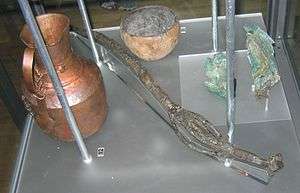Wand

A wand (sometimes magic wand) is a thin, hand-held stick or rod made of wood, stone, ivory, or metals like gold or silver. Generally, in modern language, wands are ceremonial and/or have associations with magic but there have been other uses, all stemming from the original meaning as a synonym of rod and virge, both of which had a similar development. A stick giving length and leverage is perhaps the earliest and simplest of tools. Long versions of the magic wand are usually styled in forms of staves or scepters, often with designs or an orb of a gemstone forged on the top.
Symbolism
In ecclesiastical and formal government ceremonial, special officials may carry a wand of office or staff of office representing their power. Compare in this context the function of the ceremonial mace, the sceptre, and the staff of office. Its age may be even greater, as Stone Age cave paintings show figures holding sticks, which may be symbolic representations of their power.[1]
The magic wand can also symbolize "tool"-ness. A wand isn't an actual physical tool (e.g. a gun, hammer, screwdriver, etc.) with practical physical functions, but it can aid the user to manipulate the world around them. Following an occult definition of magic— "the Science and Art of causing Change to occur in conformity with Will"— the wand represents the means by which the Will causes the conformity.
It points to the hard problem of consciousness— that from seemingly material reality, subjective conscious experiences arise. That immaterial minds can affect material reality is "real magic"— a mystery even in the modern day. Stage magicians ritually break a wand when a fellow magician dies.
Mystical, occult, and religious usage

In Pharaonic Egypt, toilette articles, weapons against possible enemies, amulets against serpents, were also left in the tomb, together with magic texts and a magic wand which enabled the ba (soul) to use them.
In classical Greco-Roman mythology, the god Hermes/Mercury has a special wand called a caduceus.
Six to eight-foot-long staves with metal tips adorning them are traditionally carried in Freemasonry during rituals of the Craft. Ceremonial uses may have several wands for different purposes, such as the Fire Wand and the Lotus Wand in the Hermetic Order of the Golden Dawn. In Zoroastrianism, there is a similar ritual implement called a barsom.
In Wicca and Ceremonial magic, practitioners use several magical tools including wands for the channeling of energy—they serve a similar purpose to the athame although the two have their distinct uses. While an athame is generally used to command, a wand is seen as more gentle and is used to invite or encourage. Though traditionally made of wood, they can also consist of metal or crystal. Practitioners usually prune a branch from an Oak, Hazel, or other tree, or may even buy wood from a hardware store, and then carve it and add decorations to personalize it; one can also purchase ready-made wands. In Wicca the wand usually represents the element air, or sometimes fire, although contemporary wand makers also create wands for the elements of earth and water. The wand is most often used by Neopagans, Wiccans, Shamans and others in rituals, healing and spell casting.
There is some scholarly opinion that the magic wand may have its roots as a symbol of the phallus. It may also have originated as the drumming stick of a shaman, especially in Central Asia and Siberia, as when using it to beat his drum or to point, to perform religious ceremonies, for healing, and in magical ceremonies.[2]
Tarot cards
"Wands" is also another name for the suit of Staves, Batons or Rods, a suit of the minor arcana of the Tarot. It is normally associated with the element of fire, representing creative energy, passion, confidence, and charisma.
Other uses
- In music, the term sometimes applies to the modern model of conductor's baton (the earlier staff and baton cantoral being heavier and thus unfit for precise gestures).
- In literary language, "wand" can be a synonym for rod as an implement for corporal punishment, in the generic sense: either a multiple rod or a single branch (switch or cane), but not a specific physical type.
- Based on their magical symbolism, stage magicians often use "magic wands" as part of their misdirection.[3] These wands are traditionally short and black, with white tips; if deprived of his magic wand, the magician may be deemed powerless. A magic wand may be transformed into other items, grow, vanish, move, display a will of its own, or behave magically in its own right.
- A lacrosse stick is colloquially referred to as a "wand."
- "To wand" is a colloquial verb that means to check something with a handheld metal detector, such as at the airport and high security buildings.[4]
- Wooden wands of about 60" in length were popular exercise implements during the Victorian era, particularly in the U.S. and in Canada, being used to perform various flexibility and strengthening routines.
- Wand is also a common reference to an automotive handbrake/parking brake, in motorsport rally drivers would refer to their hydraulic handbrakes as "the Wand"
In popular culture

The earliest magical wand or staff in Western literary canon appears in the Odyssey: that of Circe, who uses it to transform Odysseus's men into wild beasts. Italian fairy tales put them into the hands of the powerful fairies by the late Middle Ages.[5]
In the ballads such as Allison Gross and The Laily Worm and the Machrel of the Sea, the villainesses use silver wands to transform their victims.[6] In The Chronicles of Narnia: The Lion, the Witch and the Wardrobe, the White Witch's most feared tool is her wand, whose magic is capable of turning people into stone.
Magic wands commonly feature in works of fantasy fiction as spell-casting tools. Few other common denominators exist, so the capabilities of wands vary wildly. Note that wands fill basically the same role as wizards' staffs, though staffs generally convey a more 'serious' image; a fairy godmother would often use a wand, possibly with a star or some form of decoration on the end, while Gandalf would most likely not (however, in The Hobbit, he is said to use a wand, referring to his staff, to fight the goblins of the Misty Mountains and their Wargs). Gandalf's name is Northern Mannish (one of Tolkien's invented languages, similar to North Germanic languages) for "Elf of the Wand", a reference to the staff he carries. In dramatic fiction, wands can serve as weapons in magical duels. Personal wands are common in the fictional world of J. K. Rowling's Harry Potter, as necessary tools to channel out each character's magic; it is the wand that chooses its owner. A wand is also present in the Children of the Red King series in the possession of Charlie Bone as well as the popular MMORPG World of Warcraft where caster classes such as the mage and warlock use wands offensively.
See also
References
General references
-
 This article incorporates text from a publication now in the public domain: Herbermann, Charles, ed. (1913). "article name needed". Catholic Encyclopedia. New York: Robert Appleton.
This article incorporates text from a publication now in the public domain: Herbermann, Charles, ed. (1913). "article name needed". Catholic Encyclopedia. New York: Robert Appleton. - Wandlore: A Guide for the Apprentice Wandmaker ISBN 978-0993328404
Inline citations
- ↑ David Colbert, The Magical Worlds of Harry Potter, p 195, ISBN 0-9708442-0-4
- ↑ "The Reindeer People". Donsmaps.com. Retrieved 2015-05-28.
- ↑ "The magician's wand | ISBNdb.com - Book Info". ISBNdb.com. Retrieved 2015-05-28.
- ↑ "They Wanded My Bare Feet". Foxnews.com. 2005-07-25. Retrieved 2015-05-28.
- ↑ "Raffaella Benvenuto". Italian Fairies: Fate, Folletti, and Other Creatures of Legend. Endicott-studio.com. Retrieved 2015-05-28.
- ↑ Francis James Child, The English and Scottish Popular Ballads, v 1, p 315-6, Dover Publications, New York 1965
External links
-
 Media related to Magic wands at Wikimedia Commons
Media related to Magic wands at Wikimedia Commons
